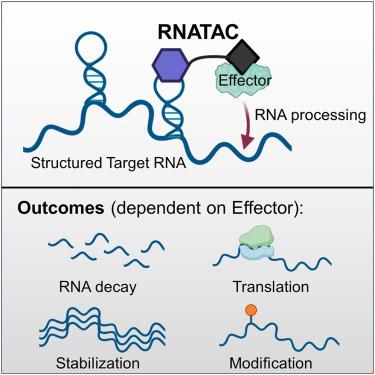当前位置:
X-MOL 学术
›
Cell Chem. Bio.
›
论文详情
Our official English website, www.x-mol.net, welcomes your
feedback! (Note: you will need to create a separate account there.)
RNATACs: Multispecific small molecules targeting RNA by induced proximity
Cell Chemical Biology ( IF 6.6 ) Pub Date : 2024-06-13 , DOI: 10.1016/j.chembiol.2024.05.006 Yan Song 1 , Jia Cui 1 , Jiaqiang Zhu 1 , Boseon Kim 1 , Mei-Ling Kuo 1 , Patrick Ryan Potts 1
Cell Chemical Biology ( IF 6.6 ) Pub Date : 2024-06-13 , DOI: 10.1016/j.chembiol.2024.05.006 Yan Song 1 , Jia Cui 1 , Jiaqiang Zhu 1 , Boseon Kim 1 , Mei-Ling Kuo 1 , Patrick Ryan Potts 1
Affiliation

|
RNA-targeting small molecules (rSMs) have become an attractive modality to tackle traditionally undruggable proteins and expand the druggable space. Among many innovative concepts, RNA-targeting chimeras (RNATACs) represent a new class of multispecific, induced proximity small molecules that act by chemically bringing RNA targets into proximity with an endogenous RNA effector, such as a ribonuclease (RNase). Depending on the RNA effector, RNATACs can alter the stability, localization, translation, or splicing of the target RNA. Although still in its infancy, this new modality has the potential for broad applications in the future to treat diseases with high unmet need. In this review, we discuss potential advantages of RNATACs, recent progress in the field, and challenges to this cutting-edge technology.
中文翻译:

RNATACs:通过诱导邻近靶向 RNA 的多特异性小分子
RNA 靶向小分子 (rSM) 已成为一种有吸引力的方式,可以处理传统上不可成药的蛋白质并扩大可成药空间。在众多创新概念中,RNA 靶向嵌合体 (RNATAC) 代表了一类新型的多特异性诱导邻近小分子,其作用是通过化学方式使 RNA 靶标与内源性 RNA 效应子(如核糖核酸酶 (RNase))接近。根据 RNA 效应子的不同,RNATAC 可以改变靶 RNA 的稳定性、定位、翻译或剪接。尽管仍处于起步阶段,但这种新模式在未来具有广泛应用的潜力,用于治疗需求未得到满足的疾病。在这篇综述中,我们讨论了 RNATACs 的潜在优势、该领域的最新进展以及这项尖端技术面临的挑战。
更新日期:2024-06-13
中文翻译:

RNATACs:通过诱导邻近靶向 RNA 的多特异性小分子
RNA 靶向小分子 (rSM) 已成为一种有吸引力的方式,可以处理传统上不可成药的蛋白质并扩大可成药空间。在众多创新概念中,RNA 靶向嵌合体 (RNATAC) 代表了一类新型的多特异性诱导邻近小分子,其作用是通过化学方式使 RNA 靶标与内源性 RNA 效应子(如核糖核酸酶 (RNase))接近。根据 RNA 效应子的不同,RNATAC 可以改变靶 RNA 的稳定性、定位、翻译或剪接。尽管仍处于起步阶段,但这种新模式在未来具有广泛应用的潜力,用于治疗需求未得到满足的疾病。在这篇综述中,我们讨论了 RNATACs 的潜在优势、该领域的最新进展以及这项尖端技术面临的挑战。































 京公网安备 11010802027423号
京公网安备 11010802027423号